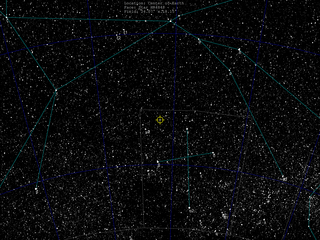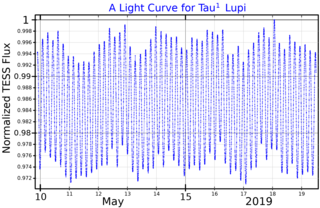Related Research Articles

Xi1 Sagittarii (ξ1 Sagittarii) is a solitary, blue-white hued star in the zodiac constellation of Sagittarius. It is visible to the naked eye with an apparent visual magnitude of +5.06. Based upon a small annual parallax shift of 1.58 mas as seen from Earth, this system is located roughly 2,100 light years from the Sun.
Kappa2 Sculptoris, Latinized from κ2 Sculptoris, is a solitary, orange-hued star in the southern constellation of Sculptor. It is faintly visible to the naked eye, with a combined apparent visual magnitude of +5.42. Based upon an annual parallax shift of 4.11 mas as measured from Earth, it is located approximately 800 light years from the Sun.
Omega2 Cygni, Latinized from ω2 Cygni, is the Bayer designation for a solitary star in the northern constellation of Cygnus. It has an apparent visual magnitude of 5.5, which is faintly visible to the naked eye on a dark night. Based upon an annual parallax shift of 8.17 mas, it is located roughly 399 light years from the Sun. At that distance, the visual magnitude is diminished by an extinction factor of 0.08 due to interstellar dust.
N Carinae is a single star in the constellation Carina, just to the northeast of the prominent star Canopus. This object has a white hue and is faintly visible to the naked eye with an apparent visual magnitude of 4.35. Based on parallax, it is located at a distance of approximately 1,360 light years from the Sun. It has an absolute magnitude of −3.75, and is drifting further away with a radial velocity of +22.5 km/s.

2 Centauri is a single star in the southern constellation of Centaurus, located approximately 183 light-years from Earth. It has the Bayer designation g Centauri; 2 Centauri is the Flamsteed designation. This object is visible to the naked eye as faint, red-hued star with an apparent visual magnitude of 4.19. It is moving away from the Earth with a heliocentric radial velocity of +41 km/s. The star is a member of the HR 1614 supercluster.
HD 75063 is a single star in the southern constellation of Vela. It has the Bayer designation of a Velorum, while HD 75063 is the identifier from the Henry Draper Catalogue. This is a naked-eye star with an apparent visual magnitude of 3.87 and has a white hue. The star is located at a distance of approximately 1,900 light-years from the Sun based on parallax measurements and has an absolute magnitude of −4.89. It is drifting further away with a radial velocity of +23 km/s.
HD 156091 is a double star in the southern constellation of Ara. The primary is a sixth magnitude giant star with stronger than normal lines of carbon, nitrogen, and barium in its spectrum. The companion is a 13th magnitude star at an angular separation of 27.4″ along a position angle of 275°, as of 2000.
HD 153791 is a double star in the southern constellation of Ara. The primary is a sixth magnitude A-type main sequence star. It has a magnitude 12.3 companion at an angular separation of 6.0″ along a position angle of 249°, as of 1999.
HD 156331 is double star in the southern constellation of Ara. As of 2014, the pair have an angular separation of less than an arc second along a position angle of 49°.
HD 130917 is a single star in the northern constellation of Boötes. It is an A-type main sequence star with a stellar classification of A4V. At an apparent magnitude of 5.80, it is visible to the naked eye.
HD 128198 is a giant star in the northern constellation of Boötes.
HD 127304 is a double star in the northern constellation of Boötes. The brighter component is a sixth magnitude A-type main sequence star with a stellar classification of A0Vs It has a faint magnitude 10.62 companion at an angular separation of 25.6″ along a position angle of 256°.
HD 102350 is a single star in the constellation Centaurus. It has a yellow hue and is visible to the naked eye with an apparent visual magnitude of 4.11. The distance to this star is approximately 390 light years based on parallax, but it is drifting closer with a radial velocity of −3 km/s. It has an absolute magnitude of −1.51.

HD 110956 is a single star in the southern constellation of Crux. It is faintly visible to the naked eye with an apparent visual magnitude of 4.62. The distance to this star is approximately 385 light years based on parallax and it is drifting further away with a radial velocity of 15.5 km/s. It is a probable member of the Lower Centaurus–Crux subgroup of the Scorpius–Centaurus association.
η Lupi, often Latinised as Eta Lupi, is a probable triple star system in the southern constellation of Lupus. It is visible to the naked eye with an apparent visual magnitude of 3.41. Based upon an annual parallax shift of 27.80 mas as seen from Earth, it is located around 136 parsecs (440 ly) distant from the Sun. It is a member of the Upper Centaurus–Lupus subgroup of the nearby Sco OB2 association.

Tau1 Lupi, Latinized from τ1 Lupi, is a solitary star in the southern constellation of Lupus. It is visible to the naked eye with an apparent visual magnitude of 4.5. Based upon an annual parallax shift of only 2.99 mas as seen from Earth, it is located about 1,090 light years from the Sun. Tau1 Lupi may be a runaway star having a peculiar velocity of 32.6±3.6 km/s. It is a member of the Upper Centaurus–Lupus sub-group of the nearby Sco OB2 association.

Upsilon Lupi, Latinized from υ Lupi, is a star system in the southern constellation of Lupus. It is faintly visible to the naked eye with an apparent visual magnitude of 5.37. Based upon an annual parallax shift of 8.02 mas as seen from Earth, it is located around 410 light years from the Sun. The two components of Upsilon Lupi share a common proper motion through space and most likely form a wide binary star system. As of 1945, the pair had an angular separation of 1.50 arc seconds along a position angle of 40°.
ψ Leonis, is a solitary star located in the zodiac constellation of Leo, to the east-northeast of Regulus. It is faintly visible to the naked eye with an apparent visual magnitude of 5.38. Based upon stellar parallax measurements, it is located around 95 light years from the Sun. At that distance, the visual magnitude of the star is diminished by an absorption factor of 0.3 due to interstellar dust.
Omega2 Tauri is a solitary, white hued star in the zodiac constellation of Taurus. It has an apparent visual magnitude of +4.9, which is bright enough to be seen with the naked eye at night. The distance to this system, as determined using an annual parallax shift of 34.55 mas as seen from the Earth, is about 94 light years.
HD 34255, also known HR 1720, is a star located in the northern circumpolar constellation Camelopardalis, the giraffe. It has an apparent magnitude of 5.60, allowing it to be faintly visible to the naked eye. The object is located relatively far at a distance of about 1.65 kly but is approaching the Solar System with a heliocentric radial velocity of −7.7 km/s.
References
- 1 2 3 4 5 van Leeuwen, F. (2007). "Validation of the new Hipparcos reduction". Astronomy and Astrophysics. 474 (2): 653–664. arXiv: 0708.1752 . Bibcode:2007A&A...474..653V. doi:10.1051/0004-6361:20078357. S2CID 18759600.
- 1 2 Famaey, B.; et al. (2005), "Local kinematics of K and M giants from CORAVEL/Hipparcos/Tycho-2 data. Revisiting the concept of superclusters", Astronomy and Astrophysics, 430: 165–186, arXiv: astro-ph/0409579 , Bibcode:2005A&A...430..165F, doi:10.1051/0004-6361:20041272, S2CID 17804304
- 1 2 Mason, B. D.; et al. (2014), "The Washington Visual Double Star Catalog", The Astronomical Journal, 122 (6): 3466–3471, Bibcode:2001AJ....122.3466M, doi: 10.1086/323920 , retrieved 2015-07-22
- 1 2 Abt, H. A. (September 1985), "Visual multiples. VIII. 1000 MK types", Astrophysical Journal Supplement Series, 59: 95–112, Bibcode:1985ApJS...59...95A, doi: 10.1086/191064
- ↑ Tetzlaff, N.; et al. (January 2011), "A catalogue of young runaway Hipparcos stars within 3 kpc from the Sun", Monthly Notices of the Royal Astronomical Society, 410 (1): 190–200, arXiv: 1007.4883 , Bibcode:2011MNRAS.410..190T, doi: 10.1111/j.1365-2966.2010.17434.x , S2CID 118629873
- 1 2 McDonald, I.; et al. (2012), "Fundamental Parameters and Infrared Excesses of Hipparcos Stars", Monthly Notices of the Royal Astronomical Society, 427 (1): 343–57, arXiv: 1208.2037 , Bibcode:2012MNRAS.427..343M, doi: 10.1111/j.1365-2966.2012.21873.x , S2CID 118665352